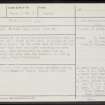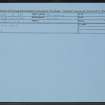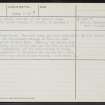Following the launch of trove.scot in February 2025 we are now planning the retiral of some of our webservices. Canmore will be switched off on 24th June 2025. Information about the closure can be found on the HES website: Retiral of HES web services | Historic Environment Scotland
Cluny Hill
Bank (Earthwork) (Early Iron Age), Bank (Earthwork) (Period Unknown)(Possible), Ditch (Period Unknown), Enclosure (Period Unknown), Fort (Period Unassigned), Hearth (Prehistoric), Paving (Period Unknown), Pit(S) (Early Iron Age), Post Hole(S) (Period Unknown), Track (Early Iron Age), Button(S) (Post Medieval), Coin(S) (Post Medieval), Crucible(S) (Prehistoric), Shot (Lead)(Period Unknown), Slag (Period Unknown)
Site Name Cluny Hill
Classification Bank (Earthwork) (Early Iron Age), Bank (Earthwork) (Period Unknown)(Possible), Ditch (Period Unknown), Enclosure (Period Unknown), Fort (Period Unassigned), Hearth (Prehistoric), Paving (Period Unknown), Pit(S) (Early Iron Age), Post Hole(S) (Period Unknown), Track (Early Iron Age), Button(S) (Post Medieval), Coin(S) (Post Medieval), Crucible(S) (Prehistoric), Shot (Lead)(Period Unknown), Slag (Period Unknown)
Alternative Name(s) Clunie
Canmore ID 15818
Site Number NJ05NW 4
NGR NJ 0445 5902
Datum OSGB36 - NGR
Permalink http://canmore.org.uk/site/15818
- Council Moray
- Parish Forres
- Former Region Grampian
- Former District Moray
- Former County Morayshire
NJ05NW 4 0445 5902
(NJ 0445 5902) British Camp (NR) (Site of)
OS 6" map (1938)
The remains of an almost circular hillfort, with a strong earth rampart and a ditch 12ft wide, enclosing an area of more than 6 acres. On the south side of the hill is a small 'post' with bank and ditch enclosing an area 10ft square. This description is taken from an accurate survey and plan made for Chalmers in 1798 by a land surveyor, Robert Macwilliam.
G Chalmers 1807
Hibbert lists this fort as being vitrified and is followed by Christison and Childe, though the latter queries it.
S Hibbert 1831; D Christison 1898; V G Childe 1946; M A Cotton 1954
The very slight scarping of the natural slope (NJ 0445 5912) is not enough, by itself, to presume a hill-fort.
Information from O G S Crawford 5 May 1943
Crawford confirmed. The only other possible indication of a fort is the fragmentary remains of what may have been a rampart at NJ 0447 5894. However, the entire hill covered by trees, is a public park and has been so greatly mutilated by landscaping and the construction of walks, that it is impossible to recognise any remains of a fort. No trace of any vitrification was seen.
Visited by OS (RD) 19 September 1963.
Field Visit (1870)
The site of the camp is situated on the north-eastern extremity of the Cluny Hills. Part of the works at its north and north-eastern extremities can still be traced, all other signs of it are obliterated.
Ordnance Survey Object name book [1870]
Note (27 March 2015 - 18 November 2016)
A large enclosure of more than 6 acres on the Cluny Hills was surveyed in 1798 by a local land surveyor, Robert Macwilliam, for George Chalmers (1887-94, i, 131), but though Chalmers considered it to be a fort, and it appears as such on the 1st edition OS 25-inch map (Elginshire 1874, sheet 11.5), subsequent investigators, which included O G S Crawford in 1943, have not been so convinced. Nevertheless, Crawford observed the scarp shown on the N flank of the hill on the OS map, while a subsequent OS surveyor in 1963 noted a possible rampart on the S flank of the hill. The scarp low down on the N is still visible in open woodland, and in this sector is a distinct feature from the track extending along the terrace to its rear, and it can also be traced round onto the E flank; if this is the remains of an enclosure, no further traces of it can be seen elsewhere, though the S flank is more heavily infested with rhododendrons and mutilated by terraced tracks. The only other feature visible is a slight bank and ditch cutting across the W spur of the hill, but this is evidently not defensive. There are no recorded observations of vitrifaction and no grounds for the site appearing in successive lists of vitrified forts (see Cotton 1954, 81). Invasive evaluation will be required to establish the true character and date of the scarp on the N and E.
Information from An Atlas of Hillforts of Great Britain and Ireland – 18 November 2016. Atlas of Hillforts SC2924
Excavation (2015 - 2018)
NJ 04461 59032 A community archaeological excavation was undertaken on Cluny Hill, Forres, over two weeks between 19 June–1 July 2017 and 8–22 September 2018 by local volunteers and students, under the supervision of the Cluny Hill Dig team. The excavation compliments a previous desk-based assessment which synthesised and evaluated the documentary and cartographic evidence for the presence of a hillfort on Cluny Hill. Historical and archaeological testimony for the presence of a fort overwhelmingly refers back to the Antiquarian George Chalmers’ Caledonia (1807), but a small number of earlier or independent references were identified. Extensive tree planting and intrusive landscaping in the 1840s removed or obscured any remaining evidence of the ditch and bank described in the written sources. References to the hillfort in OS maps were consequently removed in 1984, due to a lack of evidence of the monument on the ground.
A LIDAR scan of Cluny Hill commissioned by the Scottish Orienteering Association in 2015 revealed two surviving portions of the ditch, visible as shallow curvilinear depressions, interrupted by landscaping and paths. The entire circuit of the ditch, estimated to be 760m, encloses an area of approximately 3.6ha. on the northernmost summit of Cluny Hill. Intermittently, the line of the ditch was shown to coincide with the modern circular footpath. In August 2016, results from a magnetometry survey interpreted in combination with the LIDAR data and a walkover survey offered additional evidence for the presence of a significant ditch and possible bank in certain areas. In addition, significant geophysical anomalies were recorded near the summit of the hill. These results, and those from subsequent geophysical surveys undertaken with volunteers as part of the community project, provided targeted areas for excavation over two seasons in 2017 and 2018.
In 2017. Trenches A–C were opened on the S side of the hill across the apparent line of the ditch, while Trench D was opened across the remaining length of the ditch on the N side of the hill. Trench E was opened on the N-facing summit of the hill, in the enclosed area, to investigate a geophysical anomaly.
Evidence of the ditch in Trenches A–D was as follows:
A: The ditch cut was 3.7m wide x 1.1m deep. A subterranean beehive on the downhill side prevented further excavation, and thus that end of the ditch cut, and any bank, could not be revealed.
B: The ditch cut was 3.8m wide x 1.3m deep. No sign of a bank. This trench also incorporated a 1m-square pit dug at some point in the late 20th century, as dated by buried plastic food wrappers.
C: The ditch cut was 2.9 m wide x 1.2m deep with a 0.5m-high bank on the downhill side. A grey, stony deposit at the top of the bank contained charred oak from timber of approximately 0.15m diameter, and which returned a radiocarbon date of 821–769 cal BC (Beta 473313; IntCal20).
D: The ditch cut was 1.1m wide by 0.9m deep. The steepness of the slope to the S prevented full excavation of the ditch cut. Evidence of the bank was unclear, though a well-preserved stake/posthole with a halo of charcoal around what must have been a sharpened tip was found on the downslope side of the ditch.
The ditch fills were largely composed of deep deposits of sterile sand, probably related to backfilling during the 19th-century landscaping activities described in documentary sources. The source of the sand is likely to be a quarry on the eastern hill which is also depicted on the 1st Edition OS map. The lack of any organic material in the interface suggests that turf was removed before backfilling and then re-laid above it. Unfortunately, this disturbance affects the security of the context in which the LBA-dated charred oak from Trench C was found. A possible fragment of saddle quern was recovered from Trench A.
Trench E was placed to explore a geophysical anomaly and a low, curvilinear earth bank. Initially opened as a test trench, Trench E was extended southward in order to investigate suspected stone paving encountered during coring. Within the 8.7x1.1m trench, tap slag, heat affected earth, and charcoal were encountered along with an area of paving. Tentatively interpreted as a metal-working area, this trench was positioned in an area of dense foliage and was backfilled for investigations to continue the following year under better conditions. The sub-surface remains of a curvilinear bank, probably the remains of a turf-walled animal enclosure, overlay an old ground surface and were unrelated to the underlying stratigraphy. Roundwood charcoal recovered from the metalworking deposits returned a radiocarbon date of 351–52 cal BC (Beta 473311; IntCal20).
A metal-detecting survey undertaken as part of the community project recovered: 13 spherical lead shot (9.4–11.1mm); a number of post-medieval buttons and coins; iron slag, likely scattered from the metalworking area in Trench E; and numerous fragments of iron, which may be related to other modern metal discovered in the topsoil. All of the above were from unstratified contexts.
In 2018, the aims of the second season were: to expand Trench E in order to further characterise the nature of the activity around the stone paving, charcoal, and tap slag; to look for additional evidence of the ditch and possible bank, and to further characterise its nature—whether a defended or simple enclosure; and to explore additional geophysical anomalies that had turned up during the survey.
Trench 1: This was an expansion of Trench E from the 2017 season. This enlarged trench revealed a paved iron-smithing hearth (surrounded by a halo of hammer scale), other areas of paving, and numerous pits and postholes, with some of the latter suggestive of a structure. Vitrified clay and several crucible fragments were found in proximity to the metalworking area. In addition, charcoal recovered from two adjacent pits returned Early Iron Age dates 748–402 cal BC (Beta 528474; IntCal20) and 512–233 cal BC (Beta 528473; IntCal20).
Trench 2: This 1 x 3.7m trench was opened up about 20m E of the 2017 season’s Trench C, in an attempt to find further evidence of the ditch and apparent bank revealed in Trench C. The cut of the ditch was evident, but there was no sign of a bank, nor of the stone and charcoal that had been found in Trench C.
Trench 3: This 2.4 x 3m trench was opened up adjacent to Trench D from the 2017 season in order to look for more evidence of a bank, and possibly a palisade, downhill from the ditch. No further evidence of post- or stake-holes, or the bank, was found, but rather what appeared to be disturbance dating to the 19th -century landscaping and backfilling of the trench.
Trench 4: This 2 x 6m trench was opened to explore a geophysical anomaly on the northern slope of the hill within the enclosed area. Excavation revealed what appeared to be a stony track or area of metalling, and a bank to one side, running obliquely downhill in a westerly direction from the area in which the metalworking deposits were found. The surface of the track predominantly comprised cracked and heat-affected cobbles. Charcoal from among stones at the base of the track returned a radiocarbon date of 390–202 cal BC (Beta 528471; IntCal20). Charcoal from the base of the bank dated to 751–408 cal BC (Beta 528472; IntCal20). The location, orientation, and radiocarbon dates all appear to suggest that the track is contemporaneous with the metalworking area. It has not yet been possible to determine whether or where the track intersects with the enclosing ditch. Finds in the vicinity of Trench 4 included several pieces of partially vitrified clay (possible furnace lining), a small drip-like piece of copper-alloy, and iron slag.
Trench 5: This 1 x 3m trench was opened on a terrace, downslope of Trench 1, to explore a geophysical anomaly, but contained no archaeology.
Trench 6: This 2 x 2 m trench was opened to explore a geophysical anomaly on the northern slope of the hill within the enclosed area. This trench contained no archaeology but did contain corroded fragments of modern sheet metal in the topsoil, which likely explains some of the magnetometry anomalies.
Trench 7: This 2 x 2m trench was opened to explore a geophysical anomaly approximately 10m to the W of trench 1. It contained one small posthole.
The radiocarbon dates (2017 and 2018)
The radiocarbon dates suggest at least two phases of activity on Cluny Hill: one between 750 and 400 BC and another between 390 and 200 BC, but possibly as late as the 1st century BC. The early Iron Age dates for the metalworking area in Trench 1/E and in the trackway (Tr 4), suggest a First Millennium date for its construction. However, since the context of charcoal in the stony bank of Trench C is insecure and not replicated in any other trench, any association with the Late Bronze Age is tentative at best. Note that all dates are given with a 95.4% probability.
Environmental samples (2017 and 2018)
Samples from the bank in Trench E were mostly roots, leaves, and beech masts, and were discarded. In Trenches E and C, charred material was common, and was largely small fragments of charred wood. In a few cases, this could be identified as oak from timbers with an estimated diameter upwards of 0.15–0.20m. One of these supplied the date for the bank in Trench C. Small diameter charred roundwood was common from samples in the metalworking area of Trench E. No identifiable seeds were recovered, apart from beech masts in Trench E, and a few charred hazel shell fragments from Trench D. The flots from the bulk samples in Trenches 1 and 4 produced numerous charred cereal grains (identified under the supervision of Dr Scott Timpany, Orkney College, UHI). These were recovered from the trackway in Trench 4, and also from pit fills in Trench E, and included Emmer wheat, hulled barley, both two-and six-row hulled barley, and naked barley. Although none of these have yet been radiocarbon dated, to do so might result in tighter dating of the features, and also help flesh out a timeline for the introduction of various crop varieties in the region. Otherwise, the samples from these two trenches contained much very finely divided charred plant matter—mostly wood—including occasional fragments of roundwood charcoal, and larger chunks of hard and softwood up to 20mm in size. Charred hazel shells were found in small quantities in Trench 4, and in pits in Trench E.
The two seasons of excavations on Cluny Hill successfully confirmed the presence of the extensive enclosing ditch reported in documentary sources, even if its status as a defensive site remains unclear. The size of the enclosure places it among the largest in the region (and as the largest within the environs of the Moray Firth). It is comparable in scale, and to a lesser extent morphology, with enclosures at Little Conval, Durn Hill, Cnoc an Duin, Hill of Newleslie, Dunideer, Knockargetty Hill and Bruce’s Camp. With evidence of ferrous and non-ferrous metalworking, Cluny Hill also joins the growing corpus of Iron Age sites in Moray with such evidence; but is set apart by its hilltop location in comparison with the typical unenclosed lowland sites, and its potential for an earlier position on the regional timeline. Radiocarbon dates from the metal-working area and trackway suggest at least two distinct phases of occupation: an early phase between 750–400 BC and a later phase from 390–200 BC, possibly extending into the1st century BC. The presence of charred grains and possible quern fragment strongly supports the likelihood of domestic occupation on the hill. The lack of any deposits that might be attributed to Pictish or medieval activity provides additional support for an Early Iron Age (or possible LBA) interpretation for the ditch. Future post-excavation work will aim to further refine the site chronology with radiocarbon dating of organic remains; conduct a full metallurgical analysis; and carry out additional geophysical survey in recently cleared areas of Cluny Hill.
Funder: (2017) Aberdeenshire Council Archaeology Service, Lancaster University, Heritage Lottery Fund, through the Moray Society/Elgin Museum. (2018), Berry Burn Community Fund via our partners The Friends of the Falconer Museum, Forres
Michael Sharpe
Radiocarbon Dating
NJ 04461 59032 Here we report a new radiocarbon date of 2346±27 BP (378–499 BC Cal; OxCal 4, IntCal20). This date is from charred, 2-row hulled barley grains that were recovered from a small pit adjacent to the smithing hearth in Trench 1. The date very closely matches another radiocarbon date from charred wood in the same pit.
Archive: NRHE (intended)
Funder: the date was provided free of charge by SUERC through their CARD fund
Michael Sharpe












